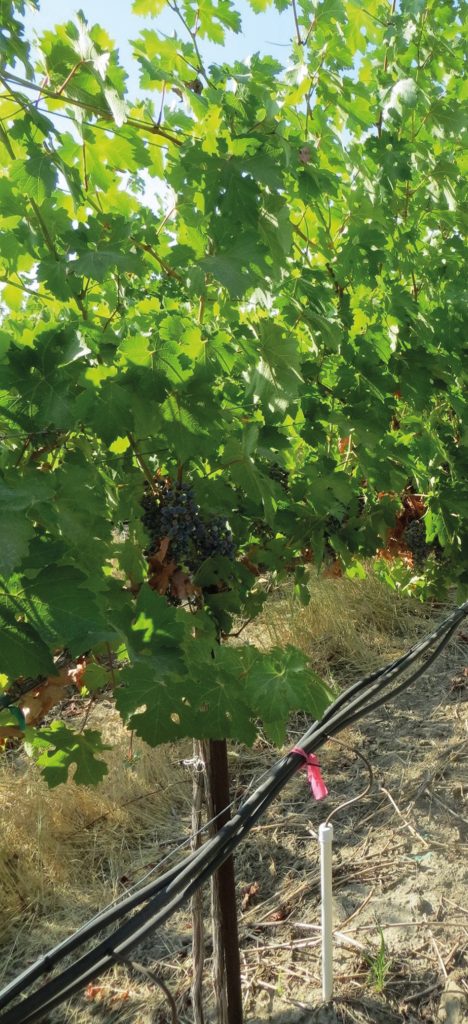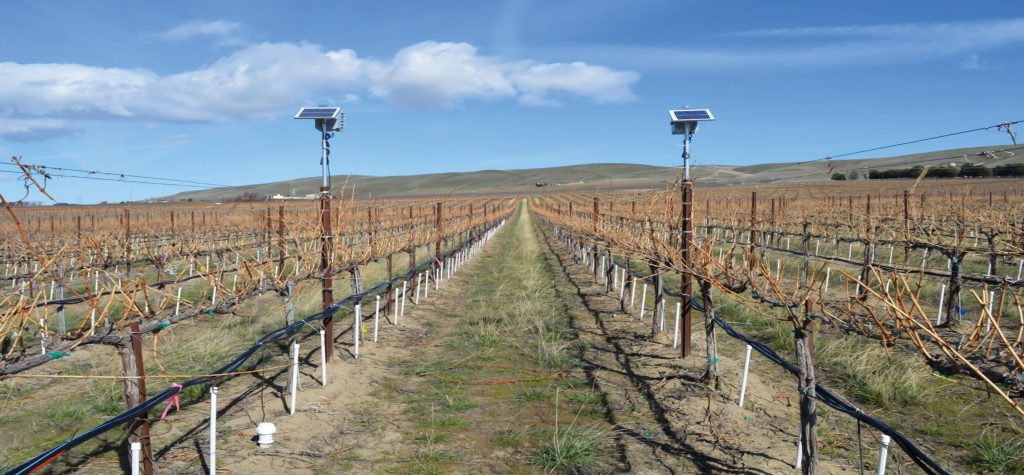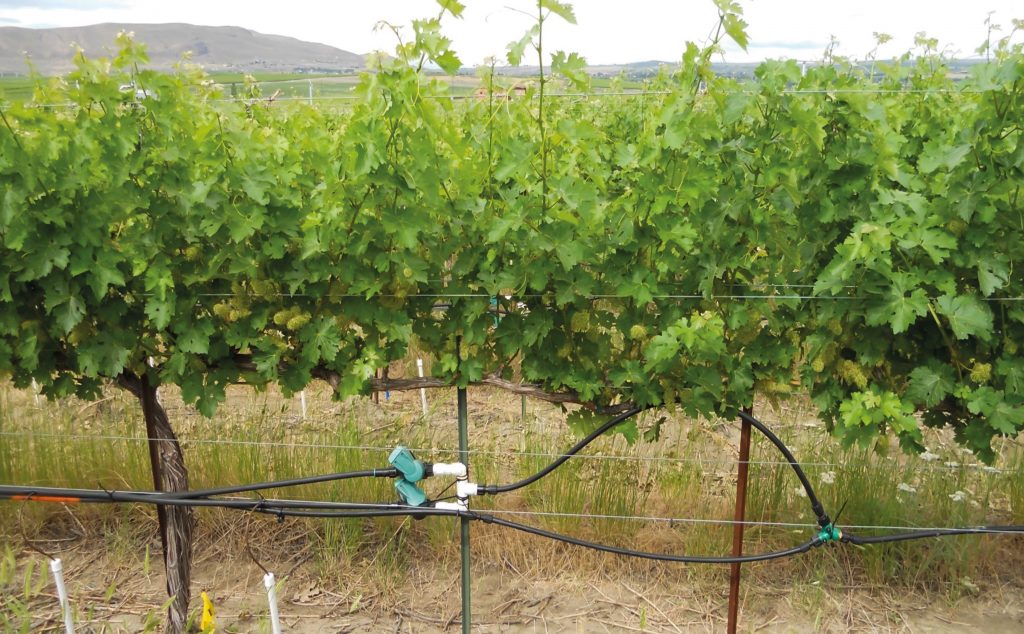Dr Pete Jacoby – New Irrigation Method Saves Water in Vineyards
Wine is a firm favourite at dinner tables everywhere, but keeping up with consumer demand is becoming increasingly difficult as the incidence and severity of drought increases. While previous irrigation systems have helped maintain grape yield and quality, they are hindered by multiple disadvantages. Dr Pete Jacoby and his team at Washington State University have developed an improved system called Direct Root-Zone irrigation, which combats many of the limitations of previous systems. With the efficacy confirmed, they aim to make their irrigation system available to growers in wine-producing regions across the globe.
Wine Producers at Risk from Droughts
Humanity has a rich history with wine production and consumption that extends back thousands of years. The historical wine production regions of Europe and the Middle East have been joined in more recent centuries by other regions across the globe, including the USA, South America, New Zealand and South Africa. With the popularity of wine continuing to grow, wine producers are seeking out improved methods of maintaining or increasing grape yield and quality to meet consumer demands.
A significant risk to grape growers is the increased prevalence and intensity of droughts, fuelled by climate change. Plants stressed severely by water shortages produce lower yields, poorer quality grapes, and are more susceptible to certain plant diseases. Many growers rely on irrigation systems to supplement the water obtained by the plants from the natural rainfall levels of the region. Although the irrigation systems currently used are successful in maintaining plant health and grape quality, a considerable amount of water is lost through evaporation and to weed species that grow amongst the vines.
Dr Pete Jacoby and his team in the Department of Crop and Soil Sciences at Washington State University have developed a new irrigation system that delivers water directly to the roots of the plants, which prevents excessive loss of water through evaporation and creates an unfavourable condition for competing weed species. After demonstrating the efficacy of their system for reducing water usage and maintaining grape quality, Dr Jacoby and his colleagues now aim to make this irrigation system commercially available to growers across the USA and the globe.

Improving on Previous Irrigation Systems
Washington State is a prolific wine production region, with more than 1000 wineries and 70 wine-grape varieties grown here alone. As with many other wine regions, the annual rainfall alone is not enough to produce high-quality grapes, and growers supplement the plants’ water requirements with irrigation.
Two main irrigation methods have previously been used in vineyards, both of which use low-pressure water trickled through the delivery system. Surface drip systems, in which water is trickled from hoses suspended above the ground onto the base of the plants, and subsurface drip irrigation systems, in which water is delivered beneath the soil around the plants through a series of buried hoses, are commonly used for many agricultural crops, including in wine-grape vineyards.
However, neither of these systems is ideal. Much of the water supplied using these methods evaporates or is snatched up by the roots of competing weeds closer to the soil surface, before it reaches the vine roots. Additionally, rodents and other wildlife have been known to damage the hosing in both of these systems, and the water emitters often become clogged with soil in subsurface irrigation systems. Repairing the components of subsurface irrigation systems is difficult and labour-intensive, which prevents many growers from using this method in their own vineyards.
Dr Jacoby and his research team have developed an irrigation system that vastly improves on both of these currently available techniques. They aimed to reduce the amount of water grape growers needed to use to produce the same quality and yield of grapes, thus saving costs, conserving water, and protecting growers from worsening drought conditions.
The result of years of development, the team’s Direct Root-Zone (DRZ) irrigation system delivers water below the ground through rigid tubes placed vertically into holes drilled into the ground near the base of the plant. Dr Jacoby and his colleagues enlisted the assistance of commercial growers in the Washington State area to refine the irrigation system, using their established vineyards of grapes used to produce Cabernet Sauvignon wine.
‘We find that grape quality increasingly improved as we put less water on the vines, because of beneficial stress to the plant system.’

Benefits of DRZ Irrigation
In contrast to subsurface irrigation systems, none of the components of the DRZ system are buried beneath the soil. Only the rigid delivery tubes are in contact with the soil, while the water emitters and hosing lines are suspended above the ground. This prevents the system from clogging up with soil or being damaged by curious wildlife.
By delivering water two feet (60 cm) below the ground directly to the vine roots, DRZ irrigation ensures that significantly more of the water supplied is taken up by the vines themselves, and not lost to evaporation or competing weed species. Delivering water at this depth also creates a surface dry-zone in the soil around the vines which hinders weed growth, because their shallow root systems are unlikely to reach the water deeper in the soil. Although a delivery tube depth of two feet is optimal for preventing water losses to evaporation and weeds, Dr Jacoby also demonstrated that the system is robust to different placement depths, with no loss of grape quality.
Water usage can be decreased dramatically by using his DRZ system, in comparison to previous irrigation systems, without sacrificing yield or quality. In fact, in many cases Dr Jacoby and his colleagues found that grape quality and yield improved when using the DRZ system. They have proposed that for most growing regions and climatic conditions, the DRZ system could reduce water usage by 40–60%, and allow for precision watering based on the needs identified by the grower.

Many winegrowers already use deficit irrigation because of the benefits to grape quality. ‘We found that grape quality increasingly improved as we put less water on the vines, because of beneficial stress responses from the grapevine,’ Dr Jacoby says. However, he also notes, ‘It is more difficult to successfully practice deficit irrigation with a surface drip system.’ The DRZ irrigation system gives growers far greater control over the amount of water delivered to the vine roots. It thus allows them to balance the water requirements of the plants at different growth stages with grape yield and quality, and to adjust for rainfall and other climatic conditions during the growing season.
In vineyards using surface irrigation systems, the vine roots tend to spread upwards towards their water source. Dr Jacoby and his team found that when used over multiple growing seasons, their DRZ system encouraged the vine roots to grow downwards. ‘By applying the water directly into the deeper soil profile, vines should respond by developing deeper roots capable of obtaining water between irrigation events and storing carbohydrate reserves for subsequent plant growth and fruit production,’ Dr Jacoby explains. Thus, these vines with roots growing deeper in the soil are less susceptible to the effects of the surface soils drying out, and consequently, are more resilient against the impacts of drought as well as daily fluctuations in temperature and water availability.

The Future of the DRZ System
Having demonstrated the effectiveness of their design, Dr Jacoby and his team now aim to make the DRZ irrigation system available to more growers in the USA and internationally. Originally, Dr Jacoby constructed the DRZ system from parts purchased off-the-shelf; however, by working with the commercialisation department at Washington State University he now aims to produce a DRZ irrigation kit that can be purchased and installed in new and existing vineyards. Installing a DRZ irrigation system is possible in both new and established vineyards because drilling small boreholes to insert the water delivery tubes doesn’t damage the vine root system, even with large plants.
Of his proposed DRZ kit Dr Jacoby says, ‘Typically, there are 800 plants per acre. There are two units per plant. Then, there’s the labour of drilling them in. If we can get the product out there for growers to buy, they can choose to install it either in existing vineyards or when they establish a new planting.’ While the pricing of these has yet to be established, installing a DRZ system is less labour intensive than subsurface irrigation systems, and is much easier to maintain. Additionally, the costs of installation may be offset by savings from reducing water usage, less cost in controlling competing weed species, and by reducing the repairs necessary to maintain the system.
Dr Jacoby and his team are also expanding their research on the DRZ system to test how well it helps maintain soil nutrient levels in the vine root zone. Subsurface irrigation is already in use with other crops such as grains, vegetables and fruit trees, and with further refinement, the DRZ system may offer similar benefits as observed in grape vineyards. With droughts predicted to increase in incidence and severity, more efficient and precise irrigation systems such as the DRZ offer farmers a vital tool in keeping up with consumer demand while coping with severe drought events.
Reference
https://doi.org/10.33548/SCIENTIA472
Meet the researcher

Dr Pete W. Jacoby
Department of Crop and Soil Sciences
Washington State University
Pullman, WA
USA
Dr Pete Jacoby earned his PhD in Plant Sciences from the University of Wyoming in 1971. He is currently Professor and Plant Ecologist in the Department of Crop and Soil Sciences at Washington State University, where his research includes improving irrigation and weed control in agricultural systems. In addition to his research and outreach activities, he also devotes time to teaching and advising PhD candidates. During his career, Dr Jacoby has published more than 50 articles in prestigious scientific journals, and has leant his expertise as a consultant to numerous organisations across the globe. He continues to expand the research and reach of his Direct Root-Zone irrigation system for grapes and other fruit crops, with the aim of making this system commercially available for growers in wine-producing regions across the world.
CONTACT:
W: http://www.css.wsu.edu/pete-jacoby
KEY COLLABORATORS
Lav R. Khot, Department of Biological Systems Engineering, Washington State University
Sindhuja Sankaran, Department of Biological Systems Engineering, Washington State University
Karen A. Sanguinet, Department of Crop and Soil Sciences, Washington State University
Haiying Tao, Department of Crop and Soil Sciences, Washington State University
FUNDING
WSU Office of Commercialization
Washington State Department of Agriculture Specialty Crop Block Program
Washington State Grape and Wine Research Program
Northwest Center for Small Fruit Research
Western Sustainable Agriculture Research and Education
FURTHER READING
X Ma, KA Sanguinet, PW Jacoby, Direct root-zone irrigation outperforms surface drip irrigation for grape yield and crop water use efficiency while restricting root growth, Agricultural Water Management, 2020, 231, 105993.
X Ma, KA Sanguinet, PW Jacoby, Performance of direct root-zone deficit irrigation on Vitis vinifera L. cv. Cabernet Sauvignon production and water use efficiency in semi-arid southcentral Washington, Agricultural Water Management, 2019, 221, 47.

Creative Commons Licence
(CC BY 4.0)
This work is licensed under a Creative Commons Attribution 4.0 International License. 
What does this mean?
Share: You can copy and redistribute the material in any medium or format
Adapt: You can change, and build upon the material for any purpose, even commercially.
Credit: You must give appropriate credit, provide a link to the license, and indicate if changes were made.
More articles you may like
Dr Wallace Pickworth | Manipulating pH in Smokeless Tobacco: Unlocking the Chemistry of Addiction
Understanding complex concepts in chemistry can be challenging for students, especially in large classes where individualised attention is limited. Traditional multiple-choice questions often focus on rote memorisation rather than deep understanding. Dr Sonia Underwood and colleagues at Michigan State University, Grand Valley State University, and Kansas State University, as part of the 3DL4US project, have developed a novel approach to create multiple-choice questions aligning with three-dimensional learning principles. This collaboration brings together a wealth of expertise and perspectives of chemistry, biology, and physics faculty who encourage students to engage with material deeper, promoting better comprehension and retention of core concepts.
Dr Sonia Underwood | Bridging the Gap in Chemistry Education: The Role of Three-Dimensional Learning
Understanding complex concepts in chemistry can be challenging for students, especially in large classes where individualised attention is limited. Traditional multiple-choice questions often focus on rote memorisation rather than deep understanding. Dr Sonia Underwood and colleagues at Michigan State University, Grand Valley State University, and Kansas State University, as part of the 3DL4US project, have developed a novel approach to create multiple-choice questions aligning with three-dimensional learning principles. This collaboration brings together a wealth of expertise and perspectives of chemistry, biology, and physics faculty who encourage students to engage with material deeper, promoting better comprehension and retention of core concepts.
Completing Quantum Mechanics: Hadronic Mechanics and its Potential for Clean Energy
Understanding how the building blocks of the world around us – such as protons and neutrons – can interact and synthesise various products can help us approach challenges such as clean energy. Sir Professor Ruggero Maria Santilli from The Institute for Basic Research considers how theories of quantum mechanics can be developed through his work on hadronic mechanics. By representing protons and neutrons as extended, Sir Santilli suggests how this could better account for processes in nuclear physics and a new outlook on clean nuclear energy via fusion.
Dr P Jacob Bueno de Mesquita | Germicidal Ultraviolet (GUV): A Powerful Tool for Improving Indoor Air Quality and Reducing Disease Transmission
The COVID-19 pandemic highlighted the critical importance of indoor air quality for public health. Dr P Jacob Bueno de Mesquita from Roger Williams University is part of a growing community of scientists dedicated to studying and implementing germicidal ultraviolet (GUV) technology to reduce the transmission of airborne pathogens. This work has the potential to dramatically improve air quality in indoor spaces and mitigate the spread of respiratory infections like COVID-19, influenza, RSV, common colds, and tuberculosis.




